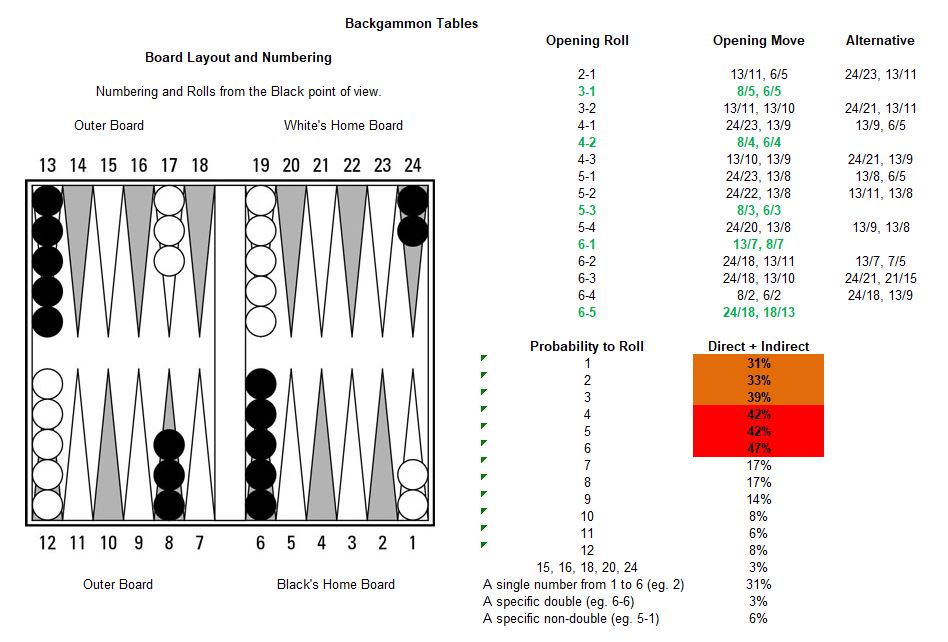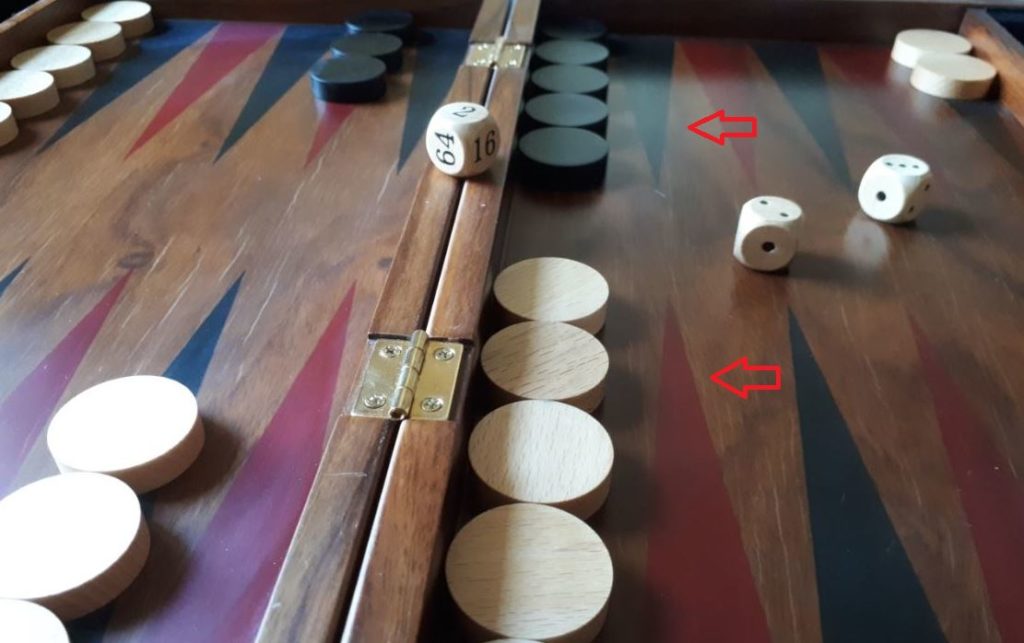Last updated on May 27, 2024
In this Deluxe Backgammon post for beginners, we will take a look at the relative importance of the named points on the board. These are the backgammon points to ponder. The first thing you will notice when you open a backgammon board is the 24 distinct elongated triangles called points. At the start of play, the checkers are setup as per the diagram below. During play, the checkers will move along these points according to the roll of the dice. The points are arranged in groups of six called quadrants. The quadrants are divided down the centre of the board by a ridge called the bar. Each player has a home board and an outer board.
The points are numbered as shown in the diagram above. Your back checkers start in your opponent’s home board on what is your 24-point. The last point in your home board is the 1-point. Of these 24 points, several of them have acquired names over the years, rather than being referred to by their number. As a beginner, you will hear these terms regularly when playing with more experienced players and it is good to get an understanding of what these names mean. These are the backgammon points to ponder.
The Ace point
As the name suggests this refers to your 1-point. Your opponent’s ace-point is on the opposite side of the board on your 24-point. This is the first point on your home board where two opposing back checkers are set in starting positions. The ace-point doesn’t sound very important, after all, it is the final point to cross when bearing off. However, Ace-point games can be some of the most intriguing.
An ace-point game occurs when you are nearing the bearing-off stage and your opponent has an anchor on the ace-point. In this instance, your opponent has been forced to adopt a holding game strategy where they are staying back and waiting for the chance to hit. At the same time, you need to enter all of your checkers into the home board and begin bearing off. This is where the intrigue starts, although you hold a lead, you need to bear-off carefully to avoid leaving blots to be hit. This is especially the case if your opponent’s home board is strong. Bear-off from the highest points where possible in the hope that a high roll will force them to abandon their anchor. Always try and keep an even number of checkers on your two highest points to avoid being forced to leave a blot because of a high double.
The Mid-point
The mid-point is your 13-point, which at the start of the game is stacked with 5 checkers. It is a secure point in the middle of the board, which is useful for several reasons. Although, not as valuable as a home board point it is still an important point to hold. The mid-point can be used as a safe haven for back checkers when they move forward. It is also the landing point for the “lover’s leap“, which is the 6-5 roll when a back checker is advanced 11 pips to the mid-point.
The mid-point is also useful because of the amount of material it carries. These 5 checkers can be used as builders in the outer board. Builders are basically checkers that are moved forward to be used to secure key points on subsequent rolls. They can also be used to attack your opponent’s back checkers if they move forward. Most importantly, the builders can be used to secure home board points.
The Bar-point
The bar-point is the 7-point on your outer board. This point is aptly named because it is immediately next to the centre bar on the backgammon board. This point is considered valuable in the opening phase of a game since a secure bar-point, together with the already secure 8 and 6-points make a three-prime. This makes a great base for extending a prime further into your home board. The bar-point, along with the 6-point, stops your opponent’s back checkers from escaping with a roll of 6 or 5. The most important backgammon points to hold early in the game, in order of importance, are the 5-point, the 4-point and the bar-point.
On the other side of the board, holding the opponent’s bar-point is also good for blocking. However, it has a slight disadvantage compared to holding the opponent’s 5-point. The bar-point can’t be used as a landing place to re-enter if you get hit. However, holding your opponent’s bar-point is still very useful in preventing your opponent from building a strong prime to trap your back checkers.
The Golden point and Golden anchor
The golden point refers to the 5-point. However, there is a bit of confusion online as to which 5-point this actually is, some argue that it is the 5-point in your opponent’s home board, while others say it is your own 5-point. The 5-point was named the golden point back in the 1970s by the backgammon legend, Paul Magriel. Specifically, Magriel was referring to the 20-point (your opponent’s 5-point) as the golden point. However, Wikipedia states that the golden point is each player’s 5-point. Some other writers have referred to your 5-point as the golden point and your 20-point as the golden anchor. This is the definition that Deluxe Backgammon uses. The 5-points on both sides of the board are the most important backgammon points in the game.
The golden point in conjunction with the 6-point forms the start of a prime in your home board to block the opponent’s back checkers. Ultimately, you would hope to extend the prime to close out your home board. The golden point is deep in your home board and along with the 6-point provides an effective barrier to entry when your opponent is trying to re-enter from the bar. Together they will block re-entry on rolls of 5 or 6, which will cause your opponent to waste a significant number of pips.
On the other side of the board, the golden anchor is also extremely valuable. It presents three significant benefits. Firstly, it provides a safe landing point for any of your checkers that get hit. This is referred to as an advanced anchor. Secondly, it prevents your opponent from creating an effective prime within their home board. Finally, it provides an attacking option against any blots your opponent leaves in their outer board as they bring their checkers home.
Summary
Hopefully, this explanation of the named points on the board will help explain why these are the backgammon points to ponder. Taking these points into consideration and understanding their importance in the game will help to improve your backgammon.



Just learning – on the naming conventions, the above diagram shows the 24 point as the black anchor point, indicating that white’s home board includes the 5 to 1 point. Is this the same convention used universally? Or does it reverse if I am playing black?
I am trying to work through other games on the internet and I am finding it a bit confusing to follow the moves.
Hi Bob, the numbering is from the black checker’s point of view. The points labelled 1 – 6 represent the black home board, where the checkers are removed. The numbering applies in reverse for the white checkers. Your furthest checkers away are on the 24 point. There is an article on backgammon notation that may help explain the layout. Thanks for commenting, Jason.